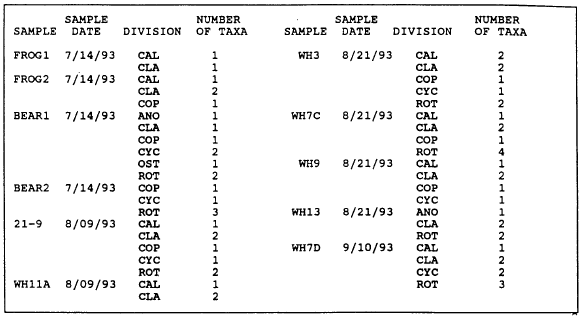|
TABLE 10. Percent similarity between ponds using comparisons. |
|
TABLE 11. Zooplankton ponds sampled, date sampled, compilation of taxonomic divisions represented and number of taxa identified in sample. |
3.3 Flora Survey Results
The White Horse Ponds were located within a mosaic of forest communities of which red fir and lodgepole pine forest were the most important. The dominant overstory tree was Shasta red fir (Abies magnifica var. shastensis) which, in combination with mountain hemlock (Tsuga mertensiana), provided a nearly closed canopy over large areas of the bluff top.
Other trees observed included lodgepole pine (Pinus contorta ssp. murrayana), western white pine (Pinus monticola) and subalpine fir (Abies lasiocarpa).
The ponds themselves supported a limited flora of vascular plants. Two aquatic plants, western quillwort (Isoetes occidentalis) and small bur-weed (Sparganium natans), were observed in Pond Three, the largest and deepest of all the ponds. These species were not observed in any other ponds. Two additional species, water sedge (Carex aquatilis) and narrow-spiked reedgrass (Calamagrostis inexpansa), were observed growing as emergent vegetation along the shallow margins of most ponds occurring on the White Horse Bluffs. Drummond’s rush (Juncus drummondii) was observed occasionally along the waterline of Pond 7, as was a single specimen each of broad-leaved twayblade(Listera convallarioides) and corn lily (Veratrum viride). These latter two species were not observed within, or adjacent to, any of the other ponds.
Transitional between the aquatic habitat of some ponds (e.g. Ponds Four and Seven) and the more xeric upland habitat of the greater portion of the bluff top were the mesic embankments. These embankments supported dense stands of grouse whortleberry(Vaccinium scoparium) and sparse stands of big whortleberry (Vaccinium membranaceum). Other species occasionally observed included western wintergreen(Gaultheria humifusa) and dwarf bramble (Rubus lasiococcus). Much of Pond Four has been filled from sedimentation such that little aquatic habitat remains. Narrow-spiked reedgrass, western wintergreen, alpine everlasting (Antennaria media) and mountain spiraea (Spiraea densiflora) all contributed to the turf of the developing meadow.
The understory of the remainder of the White Horse Bluffs comprised sparse to dense stands of low shrubs, grasses and forbs. The dominant shrub was grouse whortleberry which was primarily associated with low poorly drained areas of the bluff top which were densely shaded by overstory trees. Open rocky areas supported low stands of pinemat manzanita (Arctostaphylos nevadensis) and small clumps of sulfur flower (Eriogonum umbellatum). Other understory species observed included Parry’s rush (Juncus parryi),Ross’ sedge (Carex rossii), big squirrel tail (Elymus multisetus), white-flowered hawkweed (Hieracium albiflorum), Scouler’s hawkweed (Hieracium scouleri), and sandwort (Arenaria arculeata).
***previous*** — ***next***



